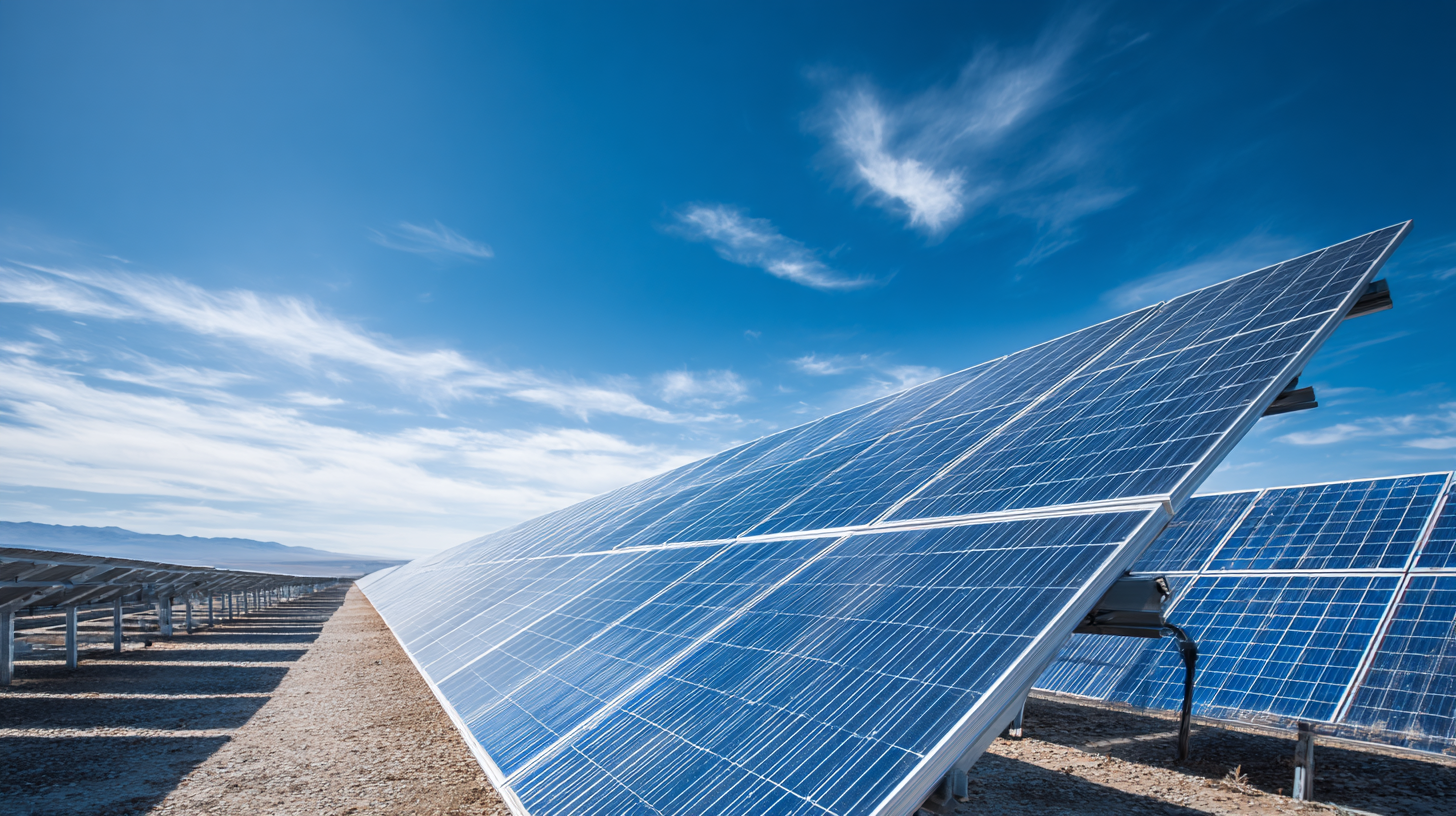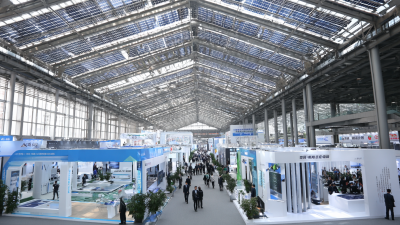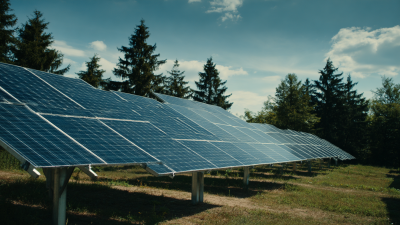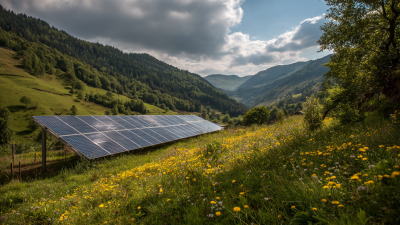Top Power Solutions for Solar Energy in 2025: Innovative Technologies for a Sustainable Future
In the rapidly evolving landscape of renewable energy, solar power has emerged as a cornerstone of sustainable solutions for the future. As we approach 2025, innovative technologies are poised to redefine the "power solutions solar" industry, enhancing efficiency and accessibility for consumers and businesses alike. According to a recent report by the International Renewable Energy Agency (IRENA), global installed solar capacity is projected to exceed 4,800 GW, underscoring the critical role solar energy will play in the transition to a low-carbon economy.
Experts agree that the integration of cutting-edge technologies is essential to meet this ambition. Dr. Emily Chen, a leading authority in renewable energy systems, emphasizes, "The next wave of solar innovation will focus on efficiency improvements and energy storage solutions, which are vital for maximizing the potential of solar power." As the industry evolves, we can expect to see advancements such as bifacial solar panels, enhanced inverter technologies, and smart grid integration, driving not only the efficiency of solar energy generation but also its widespread adoption.
As the demand for clean energy solutions continues to surge, the focus on "power solutions solar" will undoubtedly accelerate, paving the way for a sustainable and resilient energy future. With strategic investments in research and development, stakeholders can harness the potential of solar technology, ultimately leading to a cleaner environment and a more sustainable economy.

Innovative Photovoltaic Materials for Enhanced Solar Energy Efficiency in 2025
The advancement of photovoltaic materials is crucial for enhancing solar energy efficiency by 2025. Emerging technologies are focusing on the development of perovskite solar cells, which promise higher efficiency rates at a significantly lower production cost compared to traditional silicon-based panels. Their unique crystalline structure allows for excellent light absorption and a wide range of customization in terms of material composition, leading to better performance under various environmental conditions.

Moreover, integrated photovoltaic materials are being explored to combine solar energy generation with building materials. This integration can transform roofs and windows into energy-generating surfaces, maximizing space utilization and contributing to a building’s overall energy efficiency. Innovations such as bifacial solar cells, which capture sunlight from both sides, are also gaining traction, ensuring that more energy is harvested with minimal land use. As these novel technologies are further developed and commercialized, they hold the potential to revolutionize the solar energy landscape by making it more accessible and efficient for a sustainable future.
Advanced Energy Storage Solutions for Maximizing Solar Power Utilization
As we look forward to 2025, the integration of advanced energy storage solutions stands out as a pivotal factor in maximizing solar power utilization. According to a report by BloombergNEF, the global energy storage market is expected to reach a staggering 2,000 GWh by 2030, driven by the increasing presence of renewable energy sources like solar. Innovative technologies, such as lithium-ion and flow batteries, are leading the charge in energy storage capabilities, enabling both commercial and residential sectors to store excess solar energy efficiently. This stored power can then be used during peak demand hours or in periods of low sunlight, ultimately enhancing energy reliability.
Furthermore, solid-state batteries are gaining traction due to their greater energy density and safety features compared to traditional lithium-ion batteries. A recent study from Wood Mackenzie indicates that solid-state technology could reduce costs by up to 30% by 2025, making it a potential game-changer for the solar energy landscape. The implementation of these advanced storage solutions not only promotes sustainability by optimizing solar energy usage but also supports grid stability as more consumers and businesses shift towards renewable energy sources. As such, the future of solar power significantly hinges on the development and deployment of robust energy storage systems.
Smart Grid Technologies: Optimizing Solar Energy Distribution and Consumption
As we progress towards 2025, the role of smart grid technologies in optimizing solar energy distribution and consumption is becoming increasingly vital. Reports indicate that the global smart grid market is projected to grow at a compound annual growth rate (CAGR) of approximately 18% from 2021 to 2026, with investments expected to exceed $82 billion by 2026. These technologies enable real-time data communication between energy producers and consumers, enhancing the efficiency of solar energy systems. The integration of smart meters and grid sensors allows for better load balancing, minimizing energy waste and ensuring that solar power is efficiently utilized.
Furthermore, advanced analytics and artificial intelligence play a crucial role in forecasting energy demand and managing supply fluctuations. According to a study by the International Renewable Energy Agency (IRENA), the implementation of smart grid solutions could increase solar energy uptake by up to 30%, reducing reliance on fossil fuels and minimizing greenhouse gas emissions. Innovative solutions, such as virtual power plants (VPPs), harness distributed solar generation and aggregate it for optimized energy dispatch, forging a path toward a more resilient and sustainable energy ecosystem. These advancements not only support the increasing penetration of solar energy but also promote consumer participation in the energy market, empowering users to manage their consumption effectively.
Top Power Solutions for Solar Energy in 2025
This chart illustrates the projected efficiency improvements in solar energy technologies and smart grid systems by 2025. The data shows the percentage increase in efficiency across different technologies that contribute to optimizing solar energy distribution and consumption.
Emerging Solar Power Management Software for Efficient Energy Monitoring
In 2025, the landscape of solar energy will be significantly shaped by emerging solar power management software designed to optimize energy monitoring and efficiency. With the increasing complexity of energy systems, this innovative software leverages digital technology to provide real-time insights into energy consumption. By enabling precise tracking and management of solar energy production and usage, these solutions empower users to make informed decisions that reduce operating costs.

Dr. Ankur Agrawal emphasizes the importance of integrating advanced energy management systems into solar operations. These systems allow businesses to not only cut costs through efficient monitoring but also ensure compliance with evolving regulatory requirements. By utilizing sophisticated analytics, companies can identify patterns and inefficiencies, making it possible to streamline their operations and enhance sustainability.
As the industry moves toward a more data-driven approach, adopting such technologies will be key to maintaining a competitive edge while contributing to a greener future.
Integrating Artificial Intelligence in Solar Energy Systems for Predictive Maintenance and Optimization
The integration of artificial intelligence (AI) into solar energy systems is transforming the landscape of predictive maintenance and optimization. By leveraging advanced analytics and machine learning, solar energy installations can achieve unprecedented levels of performance and efficiency. In mechanical engineering and electrical industries, for instance, AI-driven predictive maintenance can identify potential failures before they occur, reducing downtime and maintenance costs. This proactive approach not only enhances the reliability of solar power generation but also contributes to more sustainable energy practices.
Regionally, the application of AI in solar energy systems varies, reflecting local needs and technological readiness. For countries investing heavily in renewable energy, the incorporation of AI technologies is projected to yield significant market growth. By 2034, the global energy management market, bolstered by AI, is expected to reach $25.8 billion, reflecting a compound annual growth rate of 15.2%. Furthermore, the demand for single-axis trackers, known for their efficiency in solar energy production, is likely to rise as AI optimizes their performance, making them a key component of future solar infrastructure that aims to ensure a sustainable energy future.
Related Posts
-

Empowering Solar Innovations at the 138th China Import and Export Fair 2025
-

The Future of Solar Energy Systems Innovations Transforming Sustainability Spaces
-

Power Solar Innovations at the 2025 China Import and Export Fair Driving Sustainable Energy Solutions
-

Power Solar Innovations: Case Studies on the Surge in Renewable Energy Adoption
-

The Ultimate Guide to Maximizing Your Savings with Solar Electricity
-

Exploring the Future: How Solar Energy Systems Are Revolutionizing Sustainable Living
